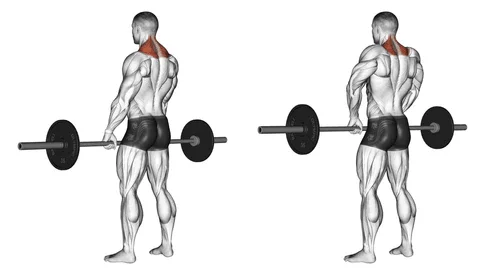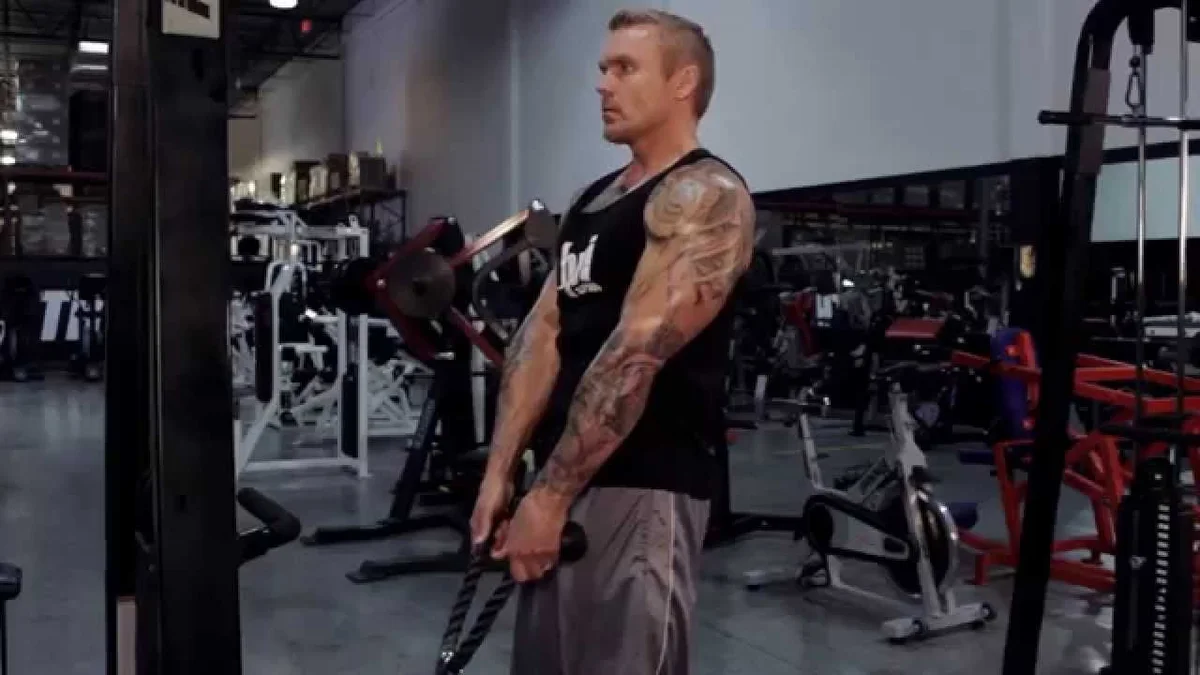A cable shrug is an excellent technique to construct larger, more powerful traps. This exercise engages the trapezius muscles, which are important for shoulder rising and shrugging. (1)
Do you have the sense that your upper traps will never grow? Are you sick of doing useless exercises that claim to target those difficult muscles? Don’t be concerned; you are not alone. Many gym-goers fail to acquire the correct level of activation in their upper traps and are sometimes irritated by their lack of development. The good news is that you don’t have to abandon your ambitions just yet.
If you haven’t tried the cable shrug yet, you may be missing out on a crucial exercise that can make all the difference. In this piece, we’ll look at the advantages of the cable shrug and how to do it correctly to maximize your upper trap gains. You’ll be one step closer to obtaining those defined traps you’ve been fantasizing about by the finish! (2)
Benefits of Cable Shrug
The cable shrug is an excellent exercise for targeting the trapezius (upper) muscle. This workout allows you to employ more weight than a standard shrug while still controlling your range of motion. This increases the time the trapezius muscle is under strain, which promotes hypertrophy and strength development. When done correctly, cable shrugs can serve to develop shoulder girdle stability and maintain a healthy posture. Furthermore, this exercise can aid in the healing of the upper trapezius following injury or tension.
Muscles worked
Trapezius Upper Fibers
The highest fibers of the trapezius muscles are in charge of elevating or lifting the shoulder blades upward.
Trapezius Middle Fibers
To retract the shoulder blades, the middle trap fibers can work independently of the higher and lower trap fibers.
Trapezius Lower Fibers
Lastly, you have a section of lower fibers that will draw the scapula down and assist the upper muscles in lifting the scapula.
How to do
Instructions for Cable Shrug
- Set two cable handles as low as possible and stand with one handle in each hand.
- To lift the shoulders, inhale and contract the traps. Squeeze the handles tightly at the top and slowly drop them back to the starting position.
- Repeat until the desired number of repetitions has been reached.
Tips
- Looking slightly up while shrugging may help to improve the contraction since traps aid to restrict head movement. A ballistic movement could result in a neck injury, thus this action should be smooth and controlled.
- High reps and explosive movements (e.g., snatch grip high pulls) tend to stimulate the traps, so plan your accessory training accordingly.
- Allowing the head to lean forward excessively while you squeeze the traps can put the neck in jeopardy and result in damage.
- Including a pause at the top of the action can aid in improving the mind-muscle connection.
Mistakes To Avoid
When doing a cable shrug, avoiding errors could mean the difference between a productive training session and an injury. Furthermore, a perfect form is vital for maximizing the advantages of the exercise. You can boost your ability to obtain your intended goals by avoiding frequent mistakes. But don’t worry, it’s not as difficult as it appears. You may complete the workout safely and effectively by avoiding mistakes and following the precise steps. Let’s start by avoiding these common blunders and incorporating this exercise into your training routine.
- Not employing the right form: When performing Cable Shrugs, the good form should be used to ensure that the exercise is completed correctly and safely. Incorrect forms might cause injury and reduce the effectiveness of the workout.
- Inadequate instruction: It is critical to provide clear direction and explanation to the audience on how to correctly conduct the exercise. Participants may become frustrated and have a lower possibility of obtaining desired fitness goals if they do not receive sufficient guidance.
- Not encouraging participants: It is critical to motivate and engage people throughout the workout in order to obtain the desired fitness results. Participants who are not encouraged may become easily disheartened and abandon the practice entirely.
Variations

Barbell Shrug
The workout Barbell Shrug is a fantastic alternative or supplement to the exercise Cable Shrug. A lifter does the barbell shrug by holding a barbell with both hands, palms facing down, and raising their shoulders to the sky while keeping their arms straight. This workout targets the traps and upper back muscles, making it a great technique to bulk up. Barbell shrugs also present an extra challenge for lifters because the weight of the barbell can be adjusted to make the exercise more difficult.

Shrugs With Bands
Cable Shrugs can be supplemented or replaced by Shrugs by Bands. This exercise, which uses resistance bands instead of weights, may be performed practically any place. Shrugs with Bands provide a greater range of motion than Cable Shrugs and allow you to add tension throughout the exercise. The bands are also a more dynamic technique to target the upper traps and neck muscles, making them ideal for athletes wishing to enhance their posture or mobility. Shrugs With Bands can also be utilized as part of a warm-up routine, making them an excellent choice for athletes of all levels.

Dumbbell Shrug
Dumbbell Shrug is an excellent complement or alternative to Cable Shrug. It is an isolation exercise that focuses on the trapezius muscles while also strengthening the upper back and neck. The dumbbell shrug motion is similar to the cable shrug, but it demands greater stability and balance since the weight is distributed differently. This exercise, which can be done with one or two dumbbells depending on the desired intensity, can be included in any upper-body workout routine.

Smith Machine Shrug
The Smith Machine Shrug is an excellent companion or alternative exercise to the Cable Shrug for targeting the trapezius muscles. The Smith Machine Shrug is performed by standing with your feet shoulder-width apart and your knees slightly bent, with a barbell attached to a Smith Machine.
The barbell is then raised to your shoulders and held for two seconds before being carefully lowered back to the starting position. This exercise is excellent for strengthening the trapezius muscles and improving shoulder mobility and strength. It can also be used as a substitute for the Cable Shrug because it requires less equipment and can be done with lesser weights, making it more accessible to individuals without access to a cable machine.

Barbell Standing Upright Row
The Barbell Standing Upright Row is an excellent alternative or supplement to the Cable Shrug. It entails standing up straight with your feet shoulder-width apart and grasping a barbell in both hands, palms facing down. The barbell should be held at arm’s length in front of your body, somewhat below your waist. From here, the arms are elevated upwards towards the shoulders, with the elbows remaining tight to the body throughout the action. The trapezius, rhomboids, and deltoids worked in the same way as the Cable Shrug. It can also, to a lesser extent, target the biceps and forearms.

Barbell Wide Grip Upright Row
The Barbell Wide Grip Upright Row is an excellent alternative or supplement to the Cable Shrug. This workout targets the trapezius muscles, as well as the biceps, deltoids, and rhomboids. It entails holding a barbell with a broad grip, palms down, and raising it to your chin. To achieve the optimum benefits, keep your shoulders back and your elbows facing outwards while executing this exercise. As it targets more of the upper back muscles, this exercise might be an excellent option or addition to the Cable Shrug for targeting the trapezius muscles.
How many cable shrugs should I do?
The quantity of cable shrugs you should perform is determined by your personal goals and fitness level. As a beginner, you should begin with three sets of 10-12 repetitions. You can gradually increase the amount of sets and repetitions as you gain strength.
It is also critical to select a weight that is difficult but not excessively heavy. The weight is too heavy if you can’t accomplish 10-12 repetitions with proper form. The weight is too light if you can complete more than 12 repetitions with proper form.
Here is a sample cable shrug workout for beginners:
Warm-up: Do 5-10 minutes of light cardio followed by some dynamic stretches.
Workout:
3 sets of 10-12 cable shrugs with a weight that is challenging but not too heavy.
Rest for 1-2 minutes between sets.
Cool-down: Do some static stretches to help your muscles recover.
FAQs
What is the difference between a shrug bar and a trap bar?
What is the correct form for shrugs?
Are barbell shrugs better than dumbbell shrugs?
What is the difference between an upright row and a shrug?
References
1. Kelso, P. (2015). Kelso’s Shrug Book. Wheatmark, Inc..
2. Beckman, E. M., & Cousins, S. D. (2019). THE SHOULDER AND ARM. ESSA’s Student Manual for Exercise Prescription, Delivery and Adherence-eBook, 140.





